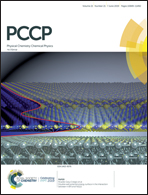Theoretical study on lithiation mechanism of benzoquinone-based macrocyclic compounds as cathode for lithium-ion batteries†
Abstract
Benzoquinone (BQ)-based macrocyclic compounds have shown great potential as cathode materials for lithium-ion batteries (LIBs) owing to their high redox potential and specific capacity. However, such materials usually have complex structures, which impede the investigation of lithiation mechanisms. Herein, we take Calix[4]quinone (C4Q) molecule as an example to develop a viable mechanism investigation method for such materials. The lithiation profile of C4Q is determined by condensed Fukui function which provides the reaction sites and orders. A correction of redox potential is proposed by leaving out the ion-transfer effect during the redox reaction based on Gibbs free energy change. The redox potential obtained by this approach shows high consistency with the experimental results. Moreover, this method can also be well extended to study the lithiation mechanism of another BQ-based macrocyclic compound (Pillar[5]quinone). Our results are promising to more deeply understand the reaction mechanism and predict the redox potential of new BQ-based macrocyclic compounds for LIBs.



 Please wait while we load your content...
Please wait while we load your content...